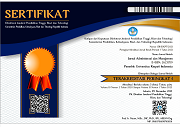Analisis Faktor-Faktor Yang Mempengaruhi Kepuasan Wisatawan Untuk Berkunjung Ke Kepulauan Riau
Abstract
Full Text:
PDFReferences
N. Soonsan and S. Sukahbot, “Testing the Role of Country and Destination Image Effect on Satisfaction and Revisit Intentions among Western Travellers,” 2019. [Online]. Available: http//:www.ajhtl.com
F. E. Hutchinson and S. D. Negara, “The Riau Islands and its Battle with COVID: Down but not Out,” 2021.
V. A. Dihni, “Kunjungan Wisman ke Kepulauan Riau Melesat 80,38% per November 2021 | Databoks,” 2022. https://databoks.katadata.co.id/datapublish/2022/01/06/kunjungan-wisman-ke-kepulauan-riau-melesat-8038-per-november-2021 (accessed Mar. 24, 2022).
P. Pahrudin, C.-T. Chen, and L.-W. Liu, “A Modified Theory of Planned Behavioral: A Case of Tourist Intention to Visit a Destination Post Pandemic Covid-19 in Indonesia,” Heliyon, vol. 7, no. 10, p. e08230, Oct. 2021, doi: 10.1016/j.heliyon.2021.e08230.
A. Mohsin, J. Lengler, and P. Chaya, “Does Travel Interest Mediate between Motives and Intention to Travel? A Case of Young Asian travellers,” J. Hosp. Tour. Manag., vol. 31, pp. 36–44, Jun. 2017, doi: 10.1016/j.jhtm.2016.08.003.
R. R. Prayogo, F. L. S. Ketaren, and R. M. Hati, “Electronic Word of Mouth, Destination Image, and Satisfaction Toward Visit Intention: an Empirical Study in Malioboro Street, Yogyakarta,” vol. 81, no. Icosop 2016, pp. 209–218, 2017, doi: 10.2991/icosop-16.2017.31.
S. Santoso, “Examining Relationships between Destination Image, Tourist Motivation, Satisfaction, and Visit Intention in Yogyakarta,” Expert J. Bus. Manag., vol. 7, no. 1, pp. 82–90, 2019, [Online]. Available: http://business.expertjournals.com
D. Maghrifani, F. Liu, and J. Sneddon, “Understanding Potential and Repeat Visitors’ Travel Intentions: The Roles of Travel Motivations, Destination Image, and Visitor Image Congruity,” J. Travel Res., 2021, doi: 10.1177/00472875211018508.
J. M. Luo and B. H. Ye, “Role of Generativity on Tourists’ Experience Expectation, Motivation and Visit Intention in Museums,” J. Hosp. Tour. Manag., vol. 43, pp. 120–126, Jun. 2020, doi: 10.1016/j.jhtm.2020.03.002.
J. Lu, K. Hung, L. Wang, M. A. Schuett, and L. Hu, “Do Perceptions of Time Affect Outbound-Travel Motivations and Intention? An Investigation among Chinese Seniors,” Tour. Manag., vol. 53, pp. 1–12, Apr. 2016, doi: 10.1016/j.tourman.2015.09.003.
Y. Hu and S. Xu, “Memorability Of A Previous Travel Experience And Revisit Intention: The Three-Way Interaction Of Nostalgia, Perceived Disappointment Risk And Extent Of Change,” J. Destin. Mark. Manag., vol. 20, no. 601, p. 100604, 2021, doi: 10.1016/j.jdmm.2021.100604.
H. Zhang, Y. Wu, and D. Buhalis, “A Model of Perceived Image, Memorable Tourism Experiences and Revisit Intention,” J. Destin. Mark. Manag., vol. 8, no. February, pp. 326–336, 2018, doi: 10.1016/j.jdmm.2017.06.004.
N. Violla Atmari and V. Wiratno Putri, “The Effect of Tourism Experience on Revisit Intention through Destination Image and Satisfaction Article Information,” 2021. [Online]. Available: http://maj.unnes.ac.id
J. W. C. Wong, I. K. W. Lai, and Z. Tao, “Sharing Memorable Tourism Experiences on Mobile Social Media and How it Influences Further Travel Decisions,” Curr. Issues Tour., vol. 23, no. 14, pp. 1773–1787, Jul. 2020, doi: 10.1080/13683500.2019.1649372.
M. Caber, M. R. González-Rodríguez, T. Albayrak, and B. Simonetti, “Does Perceived Risk Really Matter in Travel Behaviour?,” J. Vacat. Mark., vol. 26, no. 3, pp. 334–353, Jul. 2020, doi: 10.1177/1356766720927762.
M. J. Khan, S. Chelliah, and S. Ahmed, “Factors Influencing Destination Image and Visit Intention among Young Women Travellers: Role of Travel Motivation, Perceived Risks, and Travel Constraints,” Asia Pacific J. Tour. Res., vol. 22, no. 11, pp. 1139–1155, Nov. 2017, doi: 10.1080/10941665.2017.1374985.
S. Chaulagain, J. Wiitala, and X. Fu, “The Impact of Country Image and Destination Image on US Tourists’ Travel Intention,” J. Destin. Mark. Manag., vol. 12, pp. 1–11, Jun. 2019, doi: 10.1016/j.jdmm.2019.01.005.
R. Palau-Saumell, S. Forgas-Coll, C. M. Amaya-Molinar, and J. Sánchez-García, “Examining How Country Image Influences Destination Image in a Behavioral Intentions Model: The Cases of Lloret De Mar (Spain) and Cancun (Mexico),” J. Travel Tour. Mark., vol. 33, no. 7, pp. 949–965, 2016, doi: 10.1080/10548408.2015.1075456.
A. Mohammed Abubakar, “Does E-WOM Influence Destination Trust and Travel Intention: A Medical Tourism Perspective,” Econ. Res. Istraz., vol. 29, no. 1, pp. 598–611, Jan. 2016, doi: 10.1080/1331677X.2016.1189841.
K. Andriani, A. Fitri, and A. Yusri, “Analyzing Influence of Electronic Word of Mouth (Ewom) Towards Visit Intention with Destination Image as Mediating Variable: A Study on Domestic Visitors of Museum Angkut in Batu, Indonesia,” 2019, doi: 10.18551/econeurasia.2019-01.
M. R. Jalilvand, “Word-of-Mouth VS Mass Media: Their Contributions to Destination Image Formation,” Anatolia, vol. 28, no. 2, pp. 151–162, Apr. 2017, doi: 10.1080/13032917.2016.1270840.
M. R. Jalilvand and A. Heidari, “Comparing Face-to-Face and Electronic Word-of-Mouth in Destination Image Formation: The Case of Iran,” Inf. Technol. People, vol. 30, no. 4, pp. 710–735, 2017, doi: 10.1108/ITP-09-2016-0204.
N. J. Gogtay and U. M. Thatte, “Principles of Correlation Analysis,” J. Assoc. Physicians India, vol. 65, no. MARCH, pp. 78–81, 2017.
A. Purwanto et al., “Education Research Quantitative Analysis for Little Respondents: Comparing of Lisrel, Tetrad, GSCA, Amos, SmartPLS, WarpPLS, and SPSS,” 2021. [Online]. Available: https://e-journal.my.id/jsgp/article/view/1326
S. H. Park, C. M. Hsieh, and C. K. Lee, “Examining Chinese College Students’ Intention to Travel to Japan Using the Extended Theory of Planned Behavior: Testing Destination Image and the Mediating Role of Travel Constraints,” J. Travel Tour. Mark., vol. 34, no. 1, pp. 113–131, Jan. 2017, doi: 10.1080/10548408.2016.1141154.
U. Suhud, M. Allan, and G. Willson, “Hospitality and Tourism Systems: The Relationship between Push-Pull Motivation, Destination Image, and Stage of Visit Intention: The Case of Belitung Island,” vol. 14, 2021, [Online]. Available: www.publishingindia.com
S. Kanwel, Z. Lingqiang, M. Asif, J. Hwang, A. Hussain, and A. Jameel, “The Influence of Destination Image on Tourist Loyalty and Intention to Visit: Testing a Multiple Mediation Approach,” Sustain., vol. 11, no. 22, Nov. 2019, doi: 10.3390/su11226401.
A. De Nisco, N. Papadopoulos, and S. Elliot, “From International Travelling Consumer to Place Ambassador: Connecting Place Image to Tourism Satisfaction and Post-Visit Intentions,” Int. Mark. Rev., vol. 34, no. 3, pp. 425–443, 2017, doi: 10.1108/IMR-08-2015-0180.
DOI: https://doi.org/10.52643/jam.v12i4.2461
Refbacks
- There are currently no refbacks.
StatCounter

This work is licensed under a Creative Commons Attribution-ShareAlike 4.0 International License.












